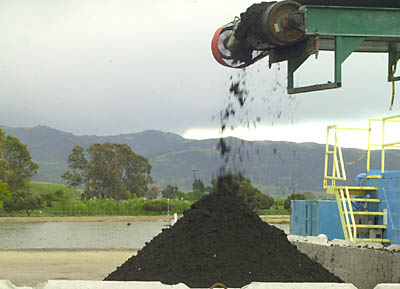
The city’s obligations to meet state orders after a 15-million
gallon wastewater spill continue, as work crews were out in the
rain last week pumping sludge from Hollister’s wastewater treatment
ponds and will continue around the clock until the current phase of
the plan is finished.
The city’s obligations to meet state orders after a 15-million gallon wastewater spill continue, as work crews were out in the rain last week pumping sludge from Hollister’s wastewater treatment ponds and will continue around the clock until the current phase of the plan is finished.
Public Works Director Clint Quilter said crews from Trimax Residuals of Edmonton, Alberta, Canada will work 24 hours per day to complete the project by Aug. 1 – the deadline imposed by the Regional Water Quality Control Board as part of the administrative civil liabilities action against the city in September.
Crews are hauling an estimated 2,000 dry tons of sludge away to the East Bay at a cost of $471,487.
“This is considered part of the city’s milestone,” Quilter said. “Time is an issue – that’s why they’ll be working 24 hours a day on the project.”
The RWQCB issued a cease-and-desist order to the city because a break in the levee at the treatment plant allowed 15 million gallons of treated wastewater to spill into the San Benito River May 4.
City officials have said flow measuring tools at the plant have been historically inaccurate. Bracewell Engineering testified that flow measurements before the spill had not exceeded the 2.6 million gallon daily flow limit imposed in the order. Bracewell is no longer employed by the city.
Quilter said part of the new treatment system will provide new headworks for an accurate reading.
The RWQCB specifically asked the city to determine how much bio-solids are separated from the liquid waste and how the San Benito River and the levees are monitored.
“The project will help increase the effluent to a higher quality,” he said.
As for city meeting the deadline, Quilter said, “We haven’t missed any yet.”
After the sludge is removed, crews will install interim baffles to separate the pond into three sections for different types of treatment processing. Baffles are multiple cells within the treatment system.
Utility Manager Jim Perrine said dividing the treatment pond into sections would create better settlement in the removal process.
“It’s better than treating it,” he said.








